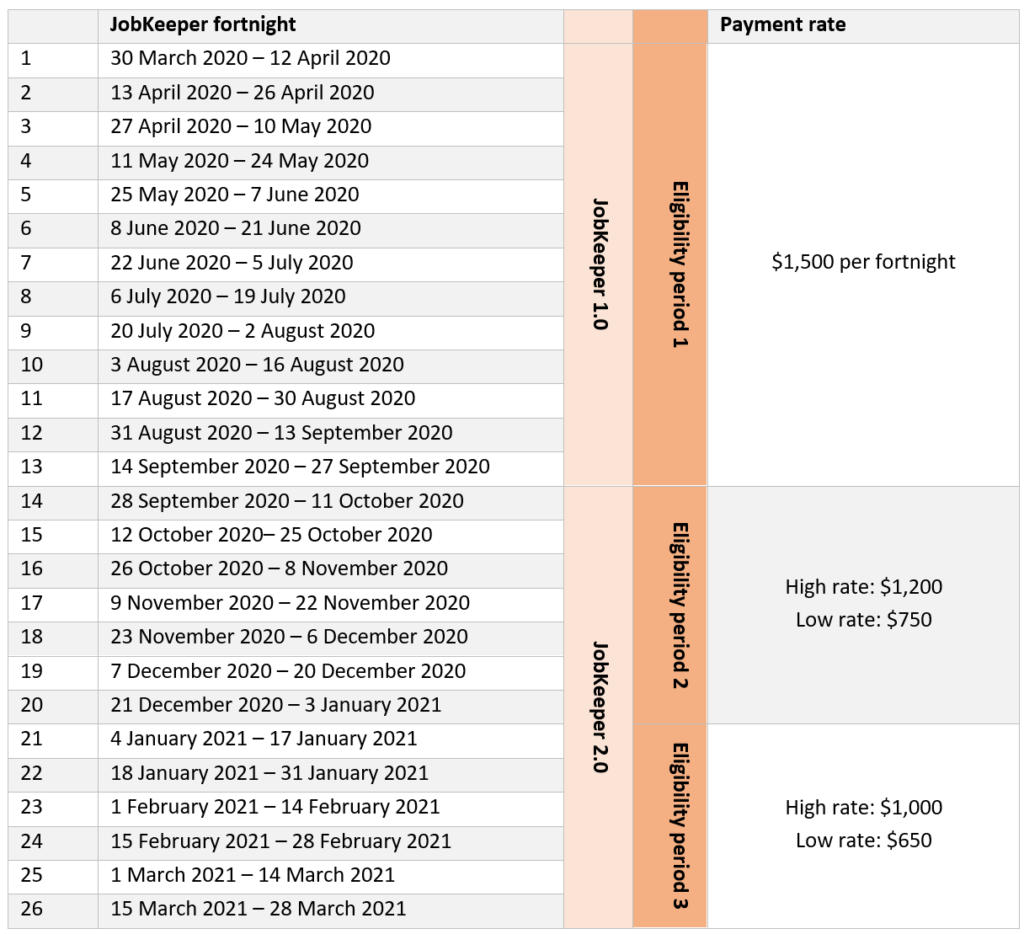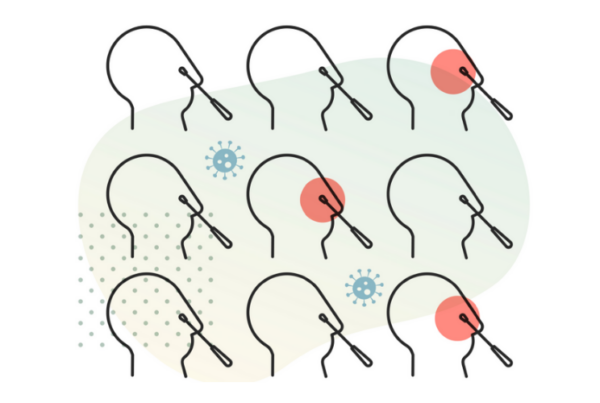
From 28 September 2020, the second tranche of the JobKeeper scheme changes the eligibility tests for employers and employees, and the method and amount paid to eligible employees.
Eligibility
To receive JobKeeper from 28 September 2020, employers will need to reassess their eligibility with reference to actual GST turnover for the September 2020 quarter (for JobKeeper payments between 28 September to 3 January 2021), and again for December 2020 quarter (for payments between 4 January 2021 to 28 March 2021).
Eligible Employers
The broad eligibility tests to access JobKeeper remain the same with an extended decline in turnover test.
On 1 March 2020, carried on a business in Australia or was a non‑profit body pursuing its objectives principally in Australia; and
- before the end of the JobKeeper fortnight, it met the decline in turnover test*:
>15% for an ACNC-registered charity (excluding universities, or schools within the meaning of the GST Act – these entities need to meet the basic turnover test).
> 50% for large businesses: aggregated turnover for the test period is likely to be $1 billion or more, or aggregated turnover for the previous year to the test period was $1 billion or more (a small business that forms part of a group that is a large business must have a >50% decline in turnover to satisfy the test).
>30% for all other qualifying entities.
And, was not:
- on 1 March 2020, subject to Major Bank Levy for any quarter ending before this date, a member of a consolidated group and another member of the group had been subject to the levy; or
- a government body of a particular kind, or a wholly-owned entity of such a body; or
- at any time in the fortnight, a provisional liquidator or liquidator has been appointed to the business or a trustee in bankruptcy had been appointed to the individual’s property.
1 March 2020 is an absolute date. An employer that had ceased trading, commenced after 1 March 2020, or was not pursuing its objectives in Australia at that date, is not eligible.
*Additional tests apply from 28 September 2020.
Additional decline in turnover tests
To receive JobKeeper payments from 28 September 2020, businesses will need to meet the basic eligibility tests and an extended decline in turnover test based on actual GST turnover. Please refer to Table Below.
| 30 March to 27 September 2020 | 28 September to 3 January 2021 | 4 January 2021 to 28 March 2021 | |
| Decline in turnover | Projected GST turnover for a relevant month or quarter is expected to fall by at least 30% (15% for ACNC-registered charities, 50% for large businesses) compared to the same period in 2019.* | Actual GST turnover in the September 2020 quarter (July, August & September) fell by at least 30% (15% for ACNC-registered charities, 50% for large businesses) compared to the same period in 2019. The decline for the quarter needs to be met to continue receiving JobKeeper payments. | Actual GST turnover in the December 2020 quarter (October, November & December)fell by at least 30% (15% for ACNC-registered charities, 50% for large businesses) compared to the same period in 2019. The decline for the quarter needs to be met to continue receiving JobKeeper payments. |
* Alternative tests potentially apply where a business fails the basic test and does not have a relevant comparison period.
Most businesses will generally use their Business Activity Statement (BAS) reporting to assess eligibility. However, as the BAS deadlines are generally not due until the month after the end of the quarter, eligibility for JobKeeper will need to be assessed in advance of the BAS reporting deadlines to meet the wage condition for eligible employees. However, the ATO will have discretion to extend the time an entity has to pay employees in order to meet the wage condition.
Alternative arrangements are expected to be put in place for businesses and not-for-profits that are not required to lodge a BAS (for example, if the entity is a member of a GST group).
Alternative tests
The Commissioner of Taxation will have discretion to set out alternative tests that would establish eligibility in specific circumstances where it is not appropriate to compare actual turnover in a quarter in 2020 with actual turnover in a quarter in 2019. These alternative tests have not as yet been released.
Eligible Employees
The Government has announced that employee eligibility tests will change from 3 August 2020 onwards.
These proposed changes mean that employees who were previously ineligible for JobKeeper because they were not employed by the entity on 1 March 2020 may now be able to receive JobKeeper payments if they were employed by the entity on 1 July 2020 and can fulfil all of the other eligibility requirements.
On 1 July 2020 (previously 1 March 2020):
- Was aged 16 years and over; and
- If the individual was aged 16 or 17, was either financially independent or was not undertaking full-time study;
- Was an employee other than a casual, or was a long-term casual*; and
- Was an Australian resident (under the meaning of the Social Security Act 1991), or a resident for tax purposes and held a Subclass 444 (Special category) visa**.
And, at any point during the JobKeeper fortnight:
- Was an employee of the employer (including employees that have been stood down or rehired); and
- Was not an excluded employee: an employee receiving parental leave pay or dad and partner pay; or an employee receiving workers compensation payments in relation to total incapacity.
And, has provided the JobKeeper Payment Employee Nomination to the employer:
- Agreeing to be nominated by the employer as an eligible employee under the JobKeeper scheme; and
- Confirming that they have not agreed to be nominated by another employer; and
- If they are a long-term casual, they do not have permanent employment with another employer.
*A ‘long term casual employee’ is a person who has been employed by the business on a regular and systematic basis during the period of 12 months that ended on the applicable testing date (previously 1 March 2020, but changing to 1 July 2020). These are likely to be employees with a recurring work schedule or a reasonable expectation of ongoing work.
JobKeeper Payments
From 28 September 2020 the payment rates for JobKeeper will reduce and split into a higher and lower rate.
Whether an eligible employee can access the higher or lower rate will depend on the number of hours they worked during a 4 week test period. The Government indicates that the higher rate will apply to employees who worked at least 20 hours a week on average in the four weeks of pay periods prior to either 1 March 2020 or 1 July 2020.
| JobKeeper | 30 March to 27 September 2020 | 28 September to 3 January 2021 | 4 January 2021 to 28 March 2021 |
| Payment | $1,500 per fortnight per employee | $1,200 per fortnight per employee or business participant who worked > 20 hours per week$750 per fortnight per employee or business participant working < 20 hours per week | $1,000 per fortnight per employee or business participant who worked > 20 hours per week$650 per fortnight per employee or business participant working < 20 hours per week |
Assessing if an employee has worked 20 hours or more
JobKeeper payments from 28 September 2020 are paid at a lower rate for employees who worked less than 20 hours per week on average in the four weeks of pay periods before 1 March 2020 and the four weeks of pay periods before 1 July 2020.
The Commissioner of Taxation will have discretion to set out alternative tests for those situations where an employee’s or business participant’s hours were not usual during February or June 2020. Also, the ATO will provide guidance on how this will be dealt with when pay periods are not weekly. This guidance is not as yet available.
Can I get JobKeeper until September?
If your business and your employees passed the original eligibility tests to access JobKeeper, and you have fulfilled your wage requirements, you can continue to claim JobKeeper up until the last JobKeeper fortnight that ends on 27 September 2020. Please refer to JobKeeper fortnightly table.
JobKeeper Fortnights




